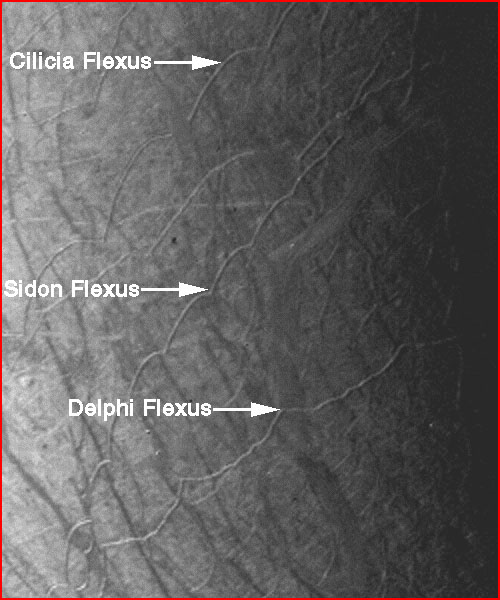
home •
about •
essential guide •
picture of the day •
thunderblogs •
news •
multimedia •
predictions •
products •
get involved •
contact
picture of the day archive subject index
Gigantic cycloid rilles on Jupiter's moon Europa. Credit: NASA Voyager II
Feb 26, 2007
The Expanding Earth Debate - Part ThreeNew conjectures about Earth expansion and crustal deformation of Jupiter's moon Europa have been offered in favor of the "expanding Earth" theory. But what has actually happened to Europa?
As we continue to investigate the two main theories of continental formation currently under discussion on various message boards and in several science forums around the net, some may notice that we are deliberately ignoring several concepts. The "hollow Earth" hypothesis, theoretical mirror-matter creation, electro-gravity and other detailed aspects to the Expanding Earth theory are not germane on this level. In future Thunderbolts Picture of the Day articles, we will consider the electrical nature of gravity and other suppositions.
Visual artist Neal Adams has produced a short video in which he attempts to prove Earth expansion using the surface of Jupiter's moon Europa as a template. Adams believes that the "fit" of Europa's blocks of surface material along the edge of giant rifts extending for hundreds of kilometers demonstrates the principle. Because S. Warren Carey affected no concern for the means by which the Earth expands, Adams has proposed a new idea in which he details how matter is created and added to the volume of our planet and, presumably, other planets. At this stage of our examination, we will use the video created by Neal Adams as primary documentation and address its problems and assumptions directly.
First, the video clip does not put the images in perspective with the rest of the terrain. The large swaths that cover the surface of Europa are characterized by features that cannot be attributed to spreading - spreading from some kind of tectonic activity notwithstanding.
1. They all exhibit braided formations at varying scale. Nothing in the geo-morphology of deep-mantle zones can explain braided topography.
2. The curvilinear sweep to the swaths suggests the sinusoidal track of electric discharges rather than canyons that were formed by cracks in an expanding crust. Similar explanations from plate tectonics theorists regarding crustal deformation and surface folding are also refuted by the observational data.
3. In many places along the swath, as the camera pans up, there is obvious evidence that the terrain on either side is underneath the ice, not separated by it. Shallower impressions of an elongated raised mound and the smoothed-over edges of a dual-ridge fault are immediately apparent as the pan begins. The appearance is that of erasure and blurring of terrain caused by the larger swaths, not cracking, eruption and freezing due to chasms in the expansion zones.
4. Spreading cannot occur in rifts at either side of another rift as in the video and leave behind ridges along the fracture, thousands of meters high. Spreading relieves tensional energy; it does not compress the crust.
5. The end of the video animates the removal of a triangular block from one side of a swath, whereupon it is lifted across the boundary to fit against the edge of its twin. Since the crust was broken into blocks and explosively thrown out from the center of the discharge track way as the electric arc passed, then broken pieces, with ridges and canyons intact, are expected to have fallen back to the surface. Suggesting that they were separated into discrete blocks because Europa's crust is spreading misses the observational cues.
The geological configurations of the giant black swaths on Europa reveal their braided shapes. In many cases, there is the impression of a huge, cylindrical column of helical filaments branded into the surface that wraps almost entirely around the planet. The scorched swaths are long parallelograms 50 kilometers long and 20 kilometers wide, connected along their short sides by narrow dark bands at approximately 45° angles. Most of the contours along the perimeter in these features have been contorted, erased and overlaid with others of similar nature. Areas covering thousands of square kilometers are shattered into blocks with identical form. How did they all spread out over this planet-sized moon?
In previous Thunderbolts Picture of the Day articles about Europa, it was shown many times that electric arcs playing across Europa in swirling, wavering blooms of plasma or in huge bolts of lightning are a more satisfactory explanation for what we see. Plate Tectonics and Earth (planetary) Expansion theories are insufficient and resort to far more inscrutable mechanisms in the accomplishment of their purposes. In the Electric Universe, what we see is what we get. Ordinary processes that we can use for experimental confirmation or falsification of ideas are available to us without recourse to a universe that must make use of creation ex-nihilo and movement without mechanism.
By Stephen Smith
__________________________________________________________________________Please visit our new "Thunderblog" page
Through the initiative of managing editor Dave Smith, weve begun the launch of a new
page called Thunderblog. Timely presentations of fact and opinion, with emphasis on
new discoveries and the explanatory power of the Electric Universe."The Electric Sky and The Electric Universe available now!

|
|

|
EXECUTIVE EDITORS:
David Talbott, Wallace Thornhill
MANAGING EDITORS:
Steve Smith, Mel Acheson
CONTRIBUTING EDITORS: Michael Armstrong, Dwardu Cardona,
Ev Cochrane,
C.J. Ransom, Don Scott, Rens van der Sluijs, Ian Tresman
WEBMASTER: Brian Talbott
Copyright 2007: thunderbolts.info
![]()
home
thunderblogs
forum
picture of the day
resources
team
updates
contact us

